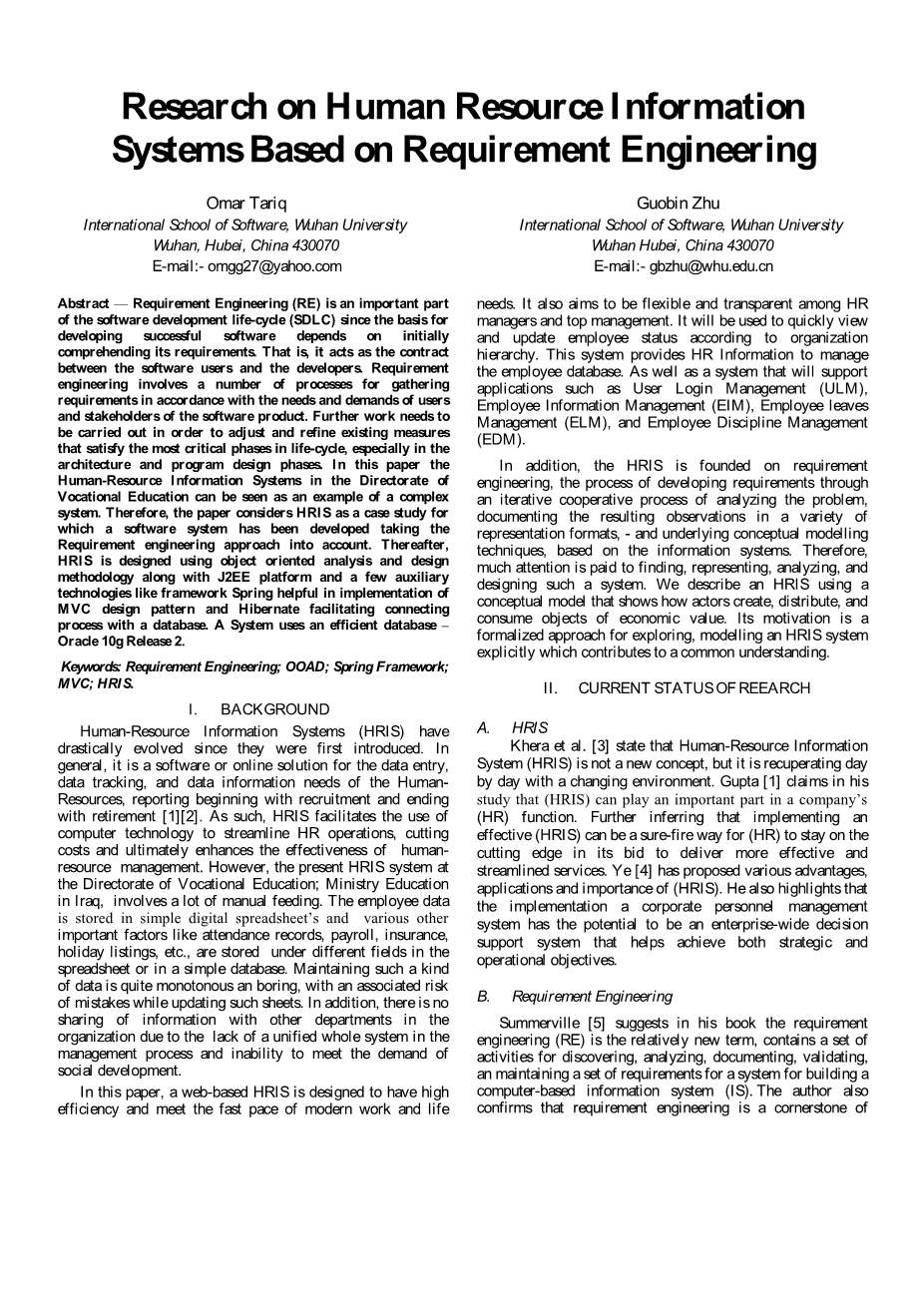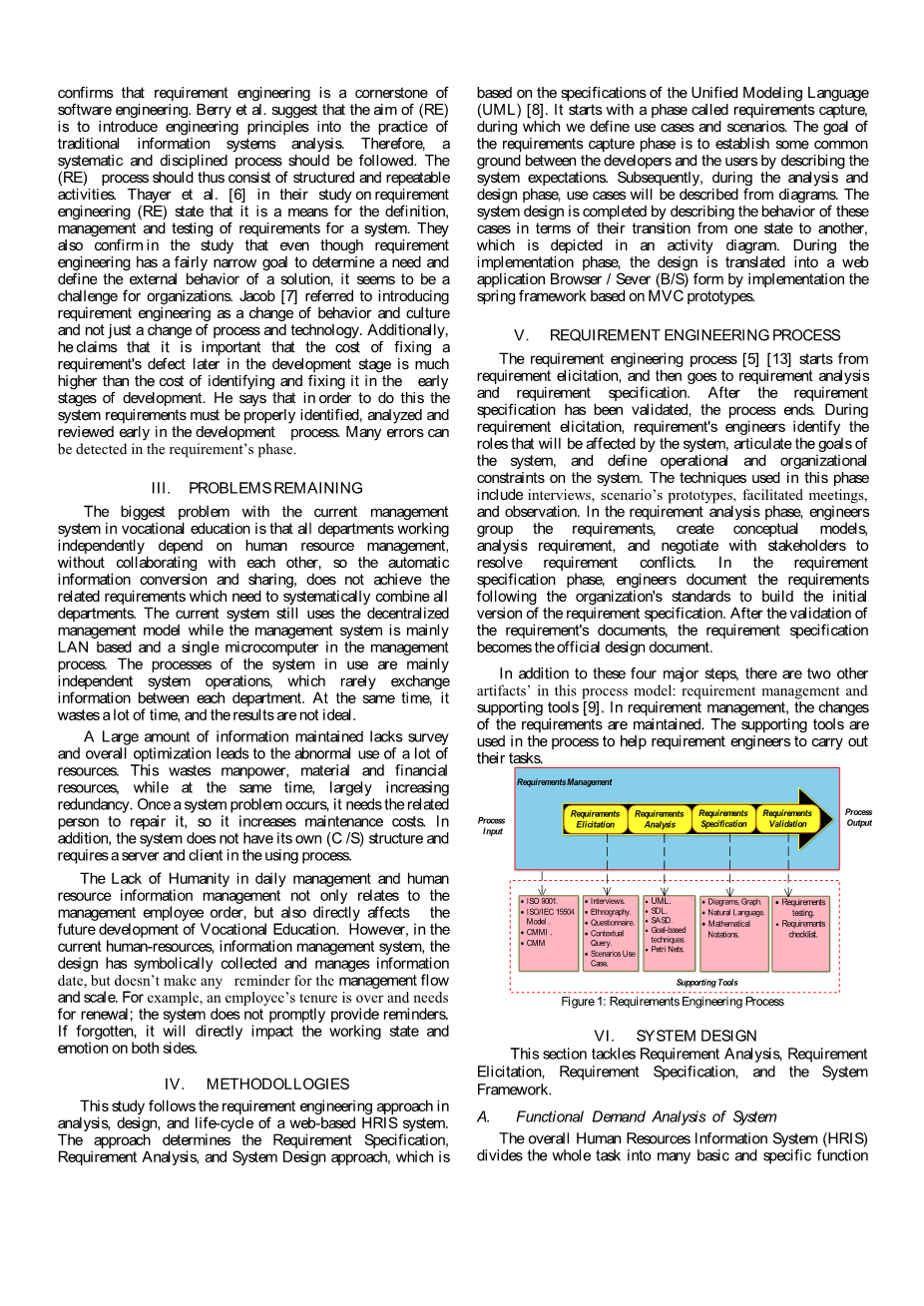

英语原文共 5 页
基于需求工程的人力资源信息系统研究
奥马尔塔里克 朱国斌
武汉大学国际软件学院 武汉大学国际软件学院
武汉, 湖北, 中国 430070 武汉, 湖北, 中国430070
E-mail:- omgg27@yahoo.com E-mail:- gbzhu@whu.edu.cn
摘要— 需求工程(RE)是软件开发生命周期(SDLC)的重要组成部分,因为开发成功软件的基础取决于最初理解其要求。也就是说,它充当软件用户和开发人员之间的联系纽带。需求工程涉及根据软件产品的用户和涉众的需求来收集需求的许多过程。为了调整和完善满足生命周期中最关键阶段的现有措施,特别是在体系结构和程序设计阶段,还需要进行进一步的工作。 本文以职业教育局人力资源信息系统为例,介绍了一个复杂的系统。因此,本文将HRIS作为一个案例研究,考虑到需求工程方法,开发了一个软件系统。之后,使用面向对象的分析和设计方法以及J2EE平台和一些辅助技术(如框架Spring)设计了HRIS,这些技术有助于实现MVC设计模式,并有助于实现与数据库的连接过程。系统使用高效的数据库 – Oracle 10g Release 2.
关键词: 需求工程; OOAD; Spring Framework; MVC; HRIS.
- 背景
人力资源信息系统(HRIS)自首次引入以来,已经发生了巨大的变化。一般来说,它是人力资源数据输入,数据跟踪和数据信息需求的软件或在线解决方案,这个解决方案的从员工入职直到退休结束[1][2]。 因此,人力资源信息系统有助于利用计算机技术简化人力资源操作,降低成本,最终提高人力资源管理的效率。但是,职业教育局目前的人力资源信息系统;拉克教育部涉及大量的人工投入。 员工数据存储在简单的数字电子表格中,其他各种重要因素(如考勤记录、工资单、保险、假期清单等)存储在电子表格的不同字段或简单数据库中。 维护这样的数据是非常单调乏味的,在更新这样的数据表时会有出错的风险。此外,由于管理过程缺乏统一的整体体系,无法满足社会发展的需要,组织内部没有与其他部门的信息共享。本文设计了一种基于网络的高效高响应系统,以满足现代工作和生活的快速发展需要。它也旨在在人力资源经理和高层管理人员之间保持灵活性和透明性。它将用于根据组织层次结构快速查看和更新员工状态。该系统提供HR信息来管理员工数据库。以及支持用户登录管理(ULM)、员工信息管理(EIM)、员工离职管理(ELM)和员工纪律管理(EDM)等应用程序的系统。
此外,HRIS建立在需求工程的基础上,即通过分析问题、以各种表示格式记录结果观察结果的迭代合作过程开发需求的过程,以及基于信息系统的基础概念建模技术。因此,更多的精力被用于寻找,表示,分析和设计这样的系统。它的动机是一种形式化的方法,用于探索,明确地建立HRIS系统,这有助于共同理解。
- 当前的研究情况
- HRIS
Khera等人 [3]指出人力资源信息系统(HRIS)不是一个新概念,而是一个日复一日、环境不断变化的系统。Gupta [1] 在他的研究中声称HRIS可以在公司职能中发挥重要作用。 进一步推断,实施有效的HRIS是HR保持领先地位以提供更有效、更精简的服务的可靠方法。Ye [4] 提出了(HRIS)的各种优点,应用和重要性。 他还强调,企业人事管理系统的实施有可能成为企业范围的决策支持系统,有助于实现战略和运营目标。
- 需求工程
Summerville [5] 在他的书中提出,需求工程(Re)是一个相对较新的术语,包含了一系列的活动,用于发现、分析、记录、验证和维护一套用于构建基于计算机的信息系统的系统的需求。作者还确认了需求工程是软件工程的基石。 Berry等人提出需求工程的目标是将工程原理引入传统信息系统分析的实践中。因此,应该遵循一个系统的、有规律的过程。需求工程过程应包括结构化和可重复的活动。Thayer等人[6] 在他们对需求工程的研究中表明,它是一种定义,管理和测试系统需求的手段。他们还在研究中确认,尽管需求工程在确定需求和定义解决方案的外部行为方面的目标相当狭窄,但对组织来说,这似乎是一个挑战。 Jacob [7] 提到将需求工程引入行为和文化的变化,而不仅仅是过程和技术的变化。此外,他还声称,重要的是,在开发阶段后期修复需求缺陷的成本远远高于在开发早期识别和修复需求缺陷的成本。 他说,为了做到这一点,必须在开发过程的早期正确地识别、分析和审查系统需求。在需求的阶段可以检测到许多错误。
- 仍存在的问题
当前职业教育管理体制存在的最大问题是,各部门独立工作,依靠人力资源管理,不相互协作,信息的自动转换和共享不能达到各部门系统结合的相关要求。目前系统仍采用分散管理模式,管理系统主要是基于局域网的,管理过程中采用单台微机。系统使用的过程主要是独立的系统操作,很少在各部门之间交换信息。同时,它浪费了大量的时间,结果也不理想。
A Large amount of information maintained lacks survey and overall optimization leads to the abnormal use of a lot of resources. This wastes manpower, material and financial resources, while at the same time, largely increasing redundancy. Once a system problem occurs, it needs the related person to repair it, so it increases maintenance costs. In addition, the system does not have its own (C /S) structure and requires a server and client in the using process.
The Lack of Humanity in daily management and human resource information management not only relates to the management employee order, but also directly affects the future development of Vocational Education. However, in the current human-resources, information management system, the design has symbolically collected and manages information date, but doesnrsquo;t make any reminder for the management flow and scale. For example, an employeersquo;s tenure is over and needs for renewal; the system does not promptly provide reminders. If forgotten, it will directly impact the working state and emotion on both sides.
IV. METHODOLLOGIES
This study follows the requirement engineering approach in analysis, design, and life-cycle of a web-based HRIS system. The approach determines the Requirement Specification, Requirement Analysis, and System Design approach, which is based on the specifications of the Unified Modeling Language (UML) [8]. It starts with a phase called requirements capture, during which we define use cases and scenarios. The goal of the requirements capture phase is to establish some common ground between the developers and the users by describing the system expectations. Subsequently, during the analysis and design phase, use cases will be described from diagrams. The system design is completed by describing the behavior of these cases in terms of their transition from one state to another, which is depicted in an activity diagram. During the implementation phase, the design is translated into a web application Browser / Sever (B/S) form by implementation the spring framework based on MVC prototypes.
V. REQUIREMENT ENGINEERING PROCESS
The requirement engineering process [5] [13] starts from requirement elicitation, and then goes to requirement analysis and requirement specification. After the requirement specification has been validated, the process ends. During requirement elicitation, requirement#39;s engineers identify the roles that will be affected by the system, articulate the goals of the system, and define operational and organizational constraints on the system. The techniques used in this phase include interviews, scenariorsquo;s prototypes, facilitated meetings, and observation. In the requirement analysis phase, engineers group the requirements, create conceptual models, analysis requirement, and negotiate with stakeholders to resolve requirement conflicts. In the requirement specification phase, engineers document the requirements following the organization#39;s standards to build the initial version
资料编号:[3615]


